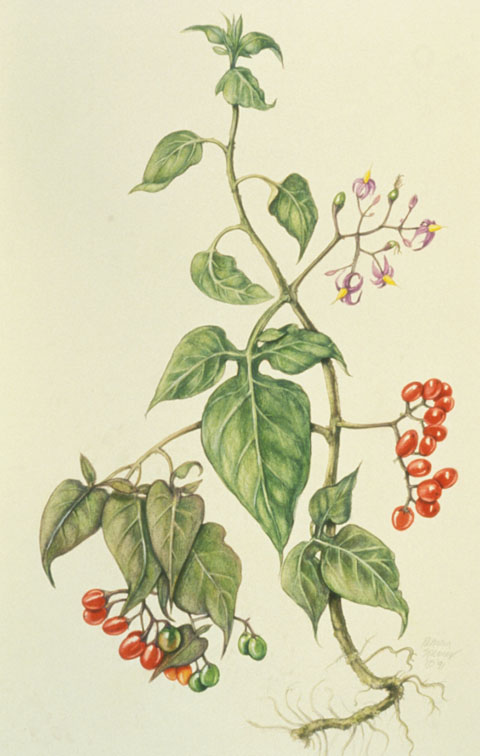
|
| Bittersweet Nightshade; Solanum Dulcamara L. |
Nightshade Family; SOLANACEÆ
|
| Bittersweet Nightshade is a semi-woody vine rarely more than half an inch thick, yet capable of clambering 30 feet or higher into
trees. Introduced from the Old World, it is now abundant here in many habitats, preferring moist, wild places. It is one of Seattle's dozen
worst weeds. Its foliage stinks like that of elderberry bushes. Beginning mid- to late May,
1/3 to
1/2 inch purplish (occasionally white) flowers
with yellow centers, bloom, gradually changing into green, then yellow, next orange, finally bright red berries. A very rare sport has berries
that stay orange even in decay, never developing the slightest red. When fully ripe the berries are harmless, not deadly. The leaves are 1 to
3 inches long and often bear lobes near their bases. After autumn and frost yellows the leaves, they drop, bidding goodbye to the
colorful clusters of egg-shaped, translucent, juicy berries hanging on the bare, withered stems. |
| Dogs can be poisoned if they eat this stinking noxious pest. It is not all bad, however: in herbal medicine one use of the plant is
for eczema. Some other names are: Woody or Climbing Bightshade, Tether Devil, Felonwood, Felonwort, Blue Bindweed, Snake's
Poison Food, Poison Flower, Scarlet Berry, Snake Berry. Note the omission of "Deadly Nightshade," despite the fact that a large number of
people so call this plant. (The original Deadly Nightshade,
Atropa Belladonna, is happily extremely rare in comparison.
It truly lives up to its ominous names: Death's Herb; Dwale; Belladonna; Naughty Man's Cherries. Some of it is grown at the University of
Washington Medicinal Herb Garden, but finding it wild west of the Cascades is difficult. I know of only
one wild stand in Seattle.) |
Three other nightshades are common wild in the Seattle area: Black Nightshade
(Solanum nigrum) and Green or Hairy
Nightshade (Solanum physalifolium), are summer annuals of disturbed soil; and Enchanter's Nightshade
(Circæa alpina), a native woodland
perennial sometimes weedy in suburban gardens.
|
Originally published as the Seattle Tilth newsletter Weed of the Month in November 1985, along with an illustration drawn by Jerri Geer. The illustration used above ws done by, and is copyrighted by, Patricia Spencer.
Back |
|
|

